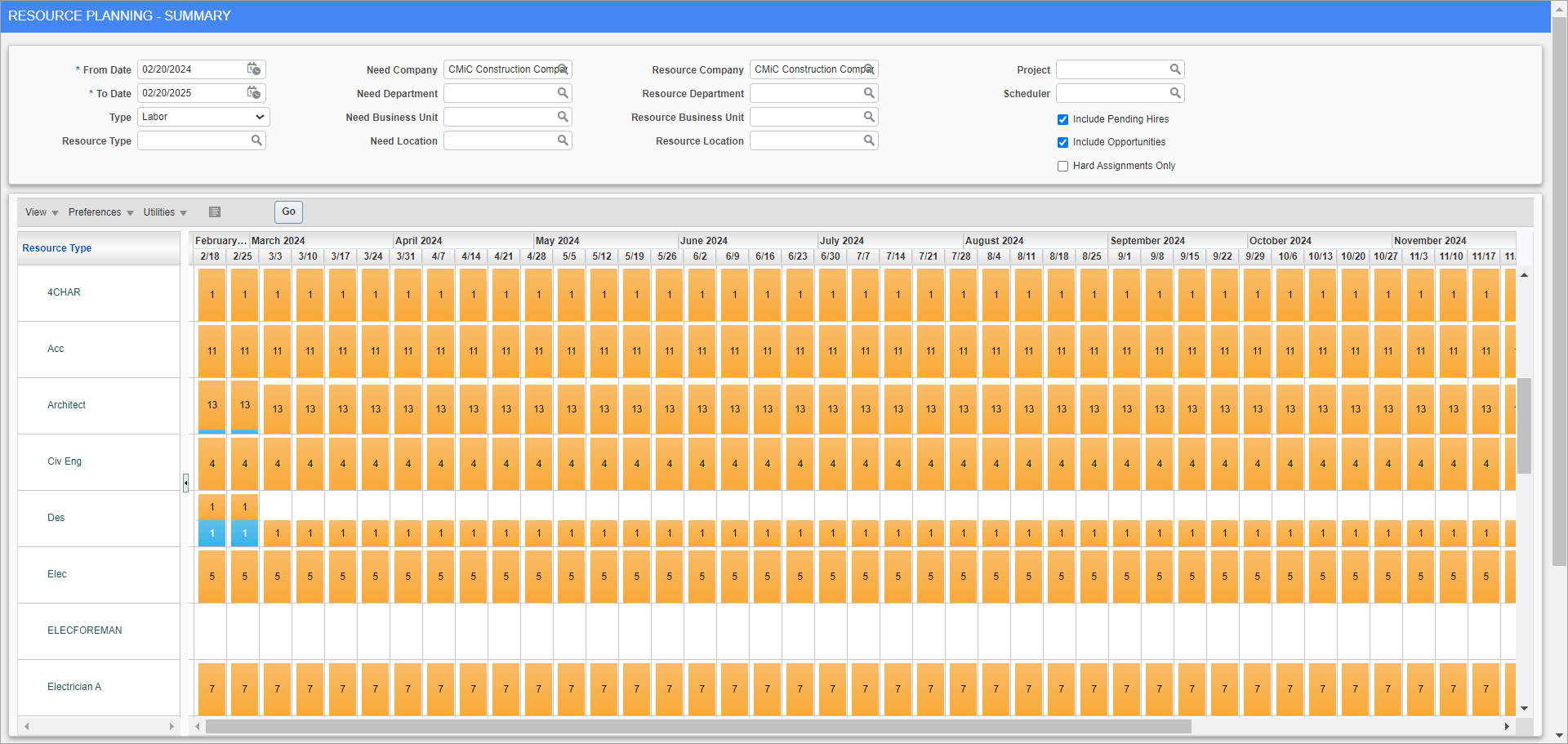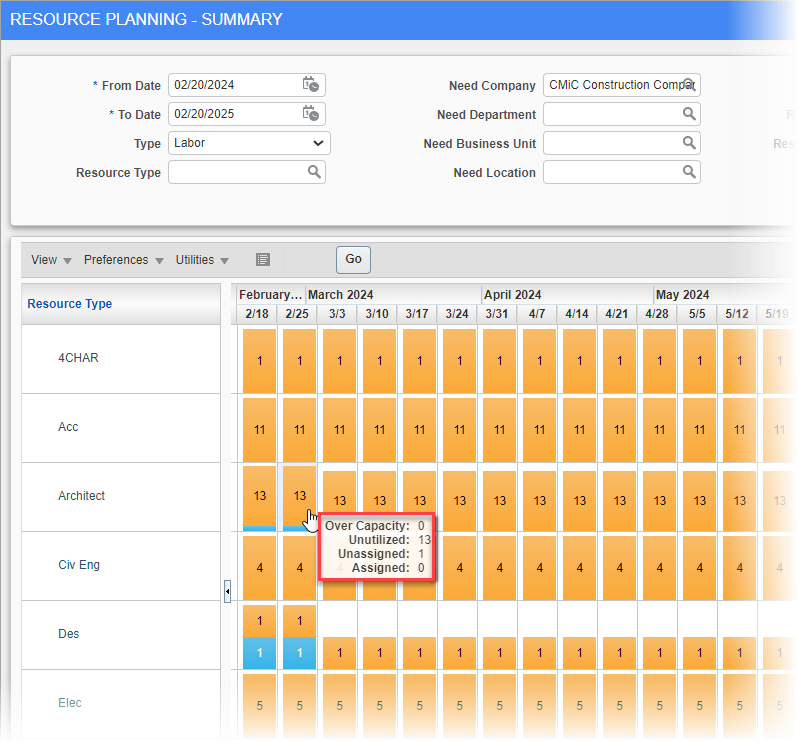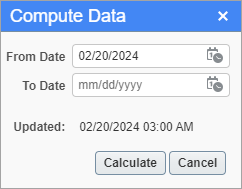Overview – Summary Screen

The Summary screen provides a graphical summary of a company’s resource needs and usage over a range of dates, for all projects or one in particular.
For each resource type a daily, weekly, or monthly breakdown of assigned, unassigned, unused, and over capacity (deficient) resources is provided in the form of a vertical bar, as shown above. Clicking a vertical bar or a resource type under the Resource Type section (found to the left of the graphical summary) launches the Resource Planning - Detail - Screen.
Labor & Equipment Resource Types
Initially, no Labor or Equipment resource types are available in the Resource Planning module. They must be made available through the Trade Codes Maintenance and Equipment Classes Maintenance screens.
For details, please refer to the following subsections: Select Trades for Resource Planning and Select Equipment Classes for Resource Planning subsections, under the Resource Planning - Setup & Maintenance - Resource Planning screen.
Labor
A Labor resource is a particular Payroll employee that is assigned to a trade.
For more information, please refer to the Assign Employees to Trades section of Setup & Maintenance.
Equipment
An Equipment resource is a particular Equipment Class, as defined in the Equipment Costing - Equipment Classes screen of the Equipment Costing module (standard Treeview path: Equipment Costing > Setup > Local Tables > Equipment Classes).
Filter - Section

The Filter section, shown above, is used to control what is displayed by the graphical summary. This allows users to set up the summary for review purposes or for assigning resources to projects that need them.
Summary Types: Resource Needs & Resource Usage

Controlling which projects and resources are included allows for a mix of two basic types of summaries at various levels (e.g. company, department, business unit).
Project Filter
To figure out the availability of a Resource type users should know the total number of assignments for that Resource type for all projects. Thus, when filtering the summary by a project, the Assigned value for a Resource type (framed above) is not affected by the project filter. So even when the project filter is used, the Assigned value is the total number of assignments for all projects.
The project filter does affect the Quantity of Needs value, which affects the Unutilized and Unassigned values (framed above). So if the project filter is used the Quantity of Needs value is for the selected project, as are the Unutilized and Unassigned values.
For details about calculating the Quantity of Needs, Unutilized, and Unassigned values, please refer to the Calculation of Resource Usage Breakdown section.
Summary of Resource Needs
Users can create a summary of needs for projects that belong to a particular company, scheduler, department, resource, or for just a single project (using the Project field). The fields used to control a needs summary are: Need Company, Scheduler, Need Department, Need Business Unit, Need Location, and Project.
NOTE: As per the preceding note about the project filter, the Assigned value (framed in preceding screenshot) is not affected by the project filter.
Summary of Resource Usage
Users can also create a summary about the availability of resources for a particular company and, if required, for a company’s department, business unit, or location. The fields used to control a resource usage summary are: Resource Company, Resource Department, Resource Business Unit, Resource Type, and Resource Location.
Filter Fields
NOTE: If a filter field is changed, pressing the [Go] button refreshes the display. Also, if you are getting unexpected results in the table, it may be due to forgotten or unnoticed filter field settings.
The filter fields in this section are described below:
|
Field |
Description |
|---|---|
|
Need Company |
Filter projects by company. Only projects belonging to specified company are included in the summary. The companies available in this LOV are the companies in the system for which the user has security access. For further details, please refer to the Access to Companies in Resource Planning section in Set Up & Maintenance. |
|
Scheduler |
Filter projects by their scheduler. Only projects with the selected scheduler assigned to them are displayed in the summary. The schedulers available in this LOV are all of the Key Players for projects that have the SCHEDULER Project Management Role code. Please refer to the Scheduler subsection in Set Up & Maintenance for details. |
|
Resource Company |
Filter resources by company. Only resources belonging to the specified company are included in the summary. |
|
Include Opportunities (checkbox) |
Controls whether or not opportunities are included in the graphical summary and in lists of projects. |
|
From Date, To Date |
Range of dates to be displayed by the graphical summary. NOTE: To improve the performance of the Summary screen, there is an Oracle job that automatically runs nightly to calculate the use of resources. These calculations are performed from the system’s current date onwards. If you need to set the From Date field to an earlier date, run the Recalculate Data utility. The Recalculate Data utility is found in the drop-down menu. For details about the Oracle Job, please refer to this guide’s System’s Oracle Job for Summary Screen’s Calculations section. |
|
Need Department |
Filter projects included in summary by department. Only projects with their Job Department field matching this selected department are displayed. A company must be selected via the Need Company field to populate this field’s LOV. Departments available in this LOV belong to the company selected via the Need Company field. |
|
Resource Department |
Filter resources included in the summary by department. Only resources belonging to the selected department (of selected company) are included in the summary. A company must be selected via the Resource Company field to populate this field’s LOVs. Departments available in this LOV belong to the company selected via the Resource Company field. |
|
Include Pending Hires (checkbox) |
Controls whether or not pending hires are included in lists of labor resources. |
|
Need Business Unit |
Business units are used if projects or opportunities at your company are grouped by business unit instead of by department. This field is used to filter projects and opportunities included in the summary by a business unit. Only projects and opportunities handled by the selected Business Unit are included in the summary. Since business units are indirectly associated to projects and opportunities through departments - as each business unit is linked to only one department - projects and opportunities are filtered by the department associated to the selected business unit. For opportunities, the Job Dept. field on the Accounting tab of the Opportunity screen is used by this filter. For Projects, their associated Job’s Default Department field on the Job Detail tab of the Enter Job screen is used by this filter. Leave this field blank to not filter by business units. Business Units Maintenance: GL > Setup > Global Tables > Business Units Department Maintenance: GL > Setup > Local Tables > Maintain Departments |
|
Resource Business Unit |
Filter resources included in summary by business units. Only resources belonging to the selected are included in the summary. For further details, please refer to the above details for the Need Business Unit field. |
|
Resource Type |
Used to select which particular resource types are displayed by the summary, for the general resource type selected via the Labor and Equipment radio buttons. |
|
Need Location |
Filter projects by their location. Only Projects at the specified location are included in the summary. This field’s LOV is maintained by the |
|
Resource Location |
Filter resources included in summary by location. Only resources at the specified location are included in the summary. This field’s LOV is maintained by the |
|
Labor, Equipment, Both (radio buttons) |
Used to select which resource types to include in the graphical summary. |
|
Project |
Used to filter projects and opportunities. Only selected projects or opportunities are included in table. A company must be selected via the Need Company field to populate this field’s list. Only Projects and Opportunities the User has rights to are available in this field’s LOV. Please refer to this guide’s following section for details: Project Security. When filtering the summary by a project, the Assigned value for a resource type is not affected by the project filter. Only projects with defined Needs show up in this LOV. |
|
Hard Assignments Only (checkbox) |
Set whether or not only hard assignments are shown. |
Menus & Buttons
|
Menus/Button |
Description |
|
View |
Settings for the display of the Resource Type pane, the Legend along bottom of screen, and a Go to Date option. |
|
Preferences |
Time Scale: settings for the summary’s time scale. For each resource type, a vertical bar provides information about the number of resources assigned, unassigned (needed), unutilized, and over-assigned for a particular range of dates. The length of each range (block of dates) is set by this setting. Date ranges can be a day, a week, or a month long. |
|
Utilities |
Recalculate Data: To improve the performance of the Summary screen, an Oracle Job automatically runs nightly to calculate the use of resources. These calculations are performed from the system’s current date onwards. If you need to set the From Date filter to an earlier date, you need to run this utility (shown below) to perform the calculations for the earlier dates. This utility can also be used if you believe the calculations need to be redone due to recent changes. In the popup, leave the To Date field empty to have the calculations performed up to the last end date of all needs.
For details about the Oracle Job, please refer to this guide’s System’s Oracle Job for Summary Screen’s Calculations section. |
|
Legend ( |
Show/Hide Legend: show or hide the legend. Legend: |
|
Go ( |
Refresh the graphical summary according to the filter fields. If a filter field is changed, this button must be used to refresh the display. |
Graphical Resource Usage Summary

The graphical resource usage summary is a grid with rows for each resource type and columns of date ranges (size of date ranges determined by the time scale setting: day, week, or month, found under Preference drop-down menu).
With respect to the parameters entered in the Filter section including the selected range of dates, this section provides a graphical summary about the usage of a company’s labor and equipment resources and a summary of project needs. It also provides an interface to access the Details screen for a particular resource type and range of dates, in order to assign a resource of that type to a project or to view details.
For each resource type and date block, a vertical bar displays the number of resources of that type that are assigned, unassigned (needed), unutilized, and over-assigned. Using the Preferences drop-down menu under the Filter section, the length of each block of dates can be set to a day, a week, or a month.
Usage Categories: Assigned, Unassigned, Unutilized, Over Capacity

For each resource type and period of time a breakdown about the usage of resources of that type is provided. Hovering over a usage category on the legend, shown above, provides its definition.
The following are the definitions for the four resource usage categories.
Assigned
The number of resources that have been assigned to needs.
Unassigned
The number of resources for which there are needs available but that have not yet been assigned.
Unutilized
The number of resources you have for which you have no needs.
Over Capacity
The number of needs you have for which you have no resources available.
Calculation of Resource Usage Breakdown

The following is the rounding rule used by the calculations, and details about how the Over Capacity, Unutilized, Unassigned, and Assigned values are calculated for a particular resource type and date range with respect to factors like an opportunity’s chance of closing and the percentage of a resource’s assignment to a need.
Rounding Rule
For each of the following calculations the final amount is rounded up for any decimal amount.
Example: If the final calculated amount equals 3.1, it is rounded up to 4.
Quantity of Needs (not displayed, but used in following calculations)
This quantity represents the number of needs for opportunities and projects of a particular resource type calculation takes into consideration the chance of closing % for opportunities, and the Assignment % value entered for an opportunity or a project need.
NOTE: An opportunity’s chance of closing % (its Get (%) field) must be kept updated to keep all dependent calculations updated.
Each opportunity need is counted using the decimal representation of the opportunity’s chance of closing %, until a need’s Assignment % value is entered. At this point, the need is counted using the chance of closing % multiplied by the Assignment % value.
Example: Before Entering Need’s Assignment %
If an opportunity’s chance of closing % = 50%, and it has 4 needs for the same resource type each of these needs is counted as 0.5, so total number of its needs for that type = 2.
Example: After Entering Need’s Assignment %
If the Assignment % value of an opportunity’s need is set to 75%, and its opportunity’s chance of closing % = 60%, the Need’s count-value = 0.75 x 0.6 = 0.45.
Each project need is counted as 1, until a need’s Assignment % value is entered, at which point the need is counted using the decimal representation of the Assignment % value.
Example:
If the Assignment % value of a project’s need is set to 10%, the project need is then counted as 0.1.
Total Resources (not displayed, but used in following calculations)
This value equals the total number of resources for the resource type regardless of assignments.
Quantity of Assigned Needs (not displayed, but used in following calculations)
This quantity takes into consideration the Assignment % value entered for the assignment of a particular resource type to a need. In counting the number of assigned needs each assignment equals the decimal representation of the Assignment % value.
Example: If there are 4 assigned needs, each with an Assignment % value of 25%, the number of assigned needs = 1.
ASSIGNED: Quantity of Assigned Resources
This quantity represent the number of resource that have been assigned to needs. It takes into consideration the Assignment % value entered for the assignment of a resource to a need. In counting the number of assignments for a resource type, each assignment equals the decimal representation of the Assignment % value.
Example
If there are 4 assignments for a particular resource type, each with an Assignment % value 25%, the number of its assignments = 1.
UNASSIGNED: Quantity of Available Resources to Fill Unassigned Needs (Quantity of Assignable Needs)
This quantity represents the number of resources for which there are needs available but that are not yet assigned. This value represents the number of needs that can be assigned available resources.
Example 1
If you have 10 unassigned resources and 4 unassigned needs, this value would be 4 as there are 4 unassigned resources available to fill the 4 unassigned needs.
Example 2
If you have 3 unassigned resources and 4 unassigned needs, this value would be 3 as there are only 3 unassigned resources available to fill the 4 unassigned needs.
The method used to calculate this value depends on whether or not this breakdown is for a case of overcapacity.
Case: Not Over Capacity
It is not a case of overcapacity if the value calculated for Quantity of Needs (detailed previously, which considers an opportunity’s chance of closing %) is equal to or less than the total number of resources.
This calculation also uses the value calculated for Quantity of Assigned Needs (detailed previously).
For this case, the following equation is used:
UNASSIGNED = Quantity of Needs - Quantity of Assigned Needs
Case: Over Capacity
It is a case of overcapacity if the value calculated for Quantity of Needs is greater than the total number of resources.
This calculation uses the value calculated for ASSIGNED (quantity of assigned resource, detailed previously), and the total amount of resources for the resource type.
If it is a case of overcapacity, the following formula is used:
UNASSIGNED = Total Resources - ASSIGNED
UNUTILIZED: Quantity of Resources Available in Excess
This quantity represents the number of resources for which there are no needs.
The method used to calculate this value depends on whether or not this breakdown is for a case of overcapacity.
Case: Not Over Capacity
It is not a case of overcapacity if the value calculated for Quantity of Needs (detailed previously) is equal to or less than the total number of s (Total Resources, detailed previously).
For this case, the following equation is used:
UNUTILIZED = Total Resources - Quantity of Needs
Case: Over Capacity
It is a case of overcapacity if the value calculated for Quantity of Needs (detailed previously) is greater than the total number of resources.
If it is a case of overcapacity, UNUTILIZED simply equals 0, as all resources are used.
OVER CAPACITY: Quantity of Needs Over Capacity
This quantity represent the number of needs for which you have no resources available. From the perspective of resources, this value indicates how many new resources are required to fill the needs.
This calculation uses the value calculated for Quantity of Needs and the total number of resources.
For this value, the following equation is used:
OVER CAPACITY = Quantity of Needs - Total Resources

 )
) )
)